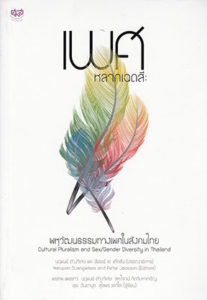
Narupon Duangwises and Peter A. Jackson, eds.
Bangkok: Princess Mahachakri Sirindhorn Anthropology Center, 2013.
Reviewed by Sura Intamool (Department of English, Faculty of Humanities, Chiang Mai University; Ph.D. candidate in Theatre Studies, National University of Singapore; NUS-HYI Joint Doctoral Scholar)
The book Sex/Gender Spectrum: Cultural Pluralism and Sex/Gender Diversity in Thailand, edited by Narupon Duangwises and Peter A. Jackson, is comprised of five academic articles adapted from intensive research funded by the Princess Mahachakri Sirindhorn Anthropology Center. The three selected articles, (1) “The Sexuality of Isan Kathoeys in Mor Lam Spaces” (ผู้สาวหน้าฮ้าน ความสัมพันธ์ระหว่างกะเทยและผู้ชาย) by Dr. Pornthep Phraekhao, (2) “Coyote Boys: The Construction of Thai Gay Identity” (เฉดความเป็นชาย” บนร่างของโคโยตี้บอย ภาพสะท้อนวัฒนธรรมบริโภคของเกย์กรุงเทพ) by Dr. Narupon Duangwises, and (3) “The World of Nang Yikay Chai Before and After the Era of Field Marshall Praek Phibunsongkhram” (นางยี่เกชาย สิ่งชำรุดในยุครัฐนิยม: เรื่องเล่าชีวิตนางยี่เกชายผ่านวรรณกรรม) by Dr. Saharoj Kittimahacharoen, present significant findings from their research on how the heteronormativity of masculine-feminine dichotomy is challenged by non-normative genders/sexualities, which are harmoniously integrated as a crucial part of complex contemporary Thailand.
Dr. Phraekhao thoroughly delineates the relationship between phu bao (heterosexual males) and kathoeys (effeminate homosexual males and male-to-female transgenders) in mor lam spaces (folksong concerts) in Isan (North-eastern Thailand). Kathoeys’ gender performativity, which is potentially challenging to heteronormativity, is conspicuously recognized; they cross-dress overly. The dressing style appears more to resemble that of heterosexual females. Consequently, kathoeys can have sexual intercourse with heterosexual males in secluded areas near the mor lam spaces. Likewise, what phu bao in the lam spaces do might be considered deviated to how heterosexual males generally act; phu bao have intercourse with kathoeys and/or even utilize their mouths to sexually stimulate kathoeys’ male genitals.
In the article of Dr. Duangwises, the author meticulously presents how “Coyote Boys” or male striptease performers in Bangkok’s gay pubs and bars, who are identified as heterosexual, bisexual, or homosexual males, enact on the gender spectrum. The performers fully enact hetero-masculinity onstage whereas they considerably or partially enact hetero-femininity offstage. The Coyote Boys’ enactment is investigated through (1) dressing and grooming of biologically male bodies, (2) choreography, (3) bodybuilding, and (4) male sexual erection.
Dr. Kittimahacharoen’s article describes male-to-female cross-dressers’ gender performativity in yikay or likay, a genre of folk dance-dramas, during mid-twentieth century Thailand. Through Curtains of a Yikay Cross-Dresser (ม่านนางรำ), a novel written by Chattabut Narudom (ชาตบุษย์ นฤดม), Dr. Kittimahacharoen explores how the male-to-female transgendered protagonist performs femininity onstage through the enactment of yikay female characters and how the protagonist femininely enacts offstage despite the vigorous reinforcement of compulsory heterosexuality, including a ban of all cross-dressing performances, under the regime of Field Marshall Praek Phibunsongkhram.
Although the three selected articles mainly deal with academically complicated ideas and might seem specifically appropriate for scholars and students of gender studies, these articles can also be appreciated by and beneficial to general readers who are interested in gender and sexuality in contemporary Thailand, as the authors cleverly explain the ideas in easy-to-understand words and in a systematic fashion.
